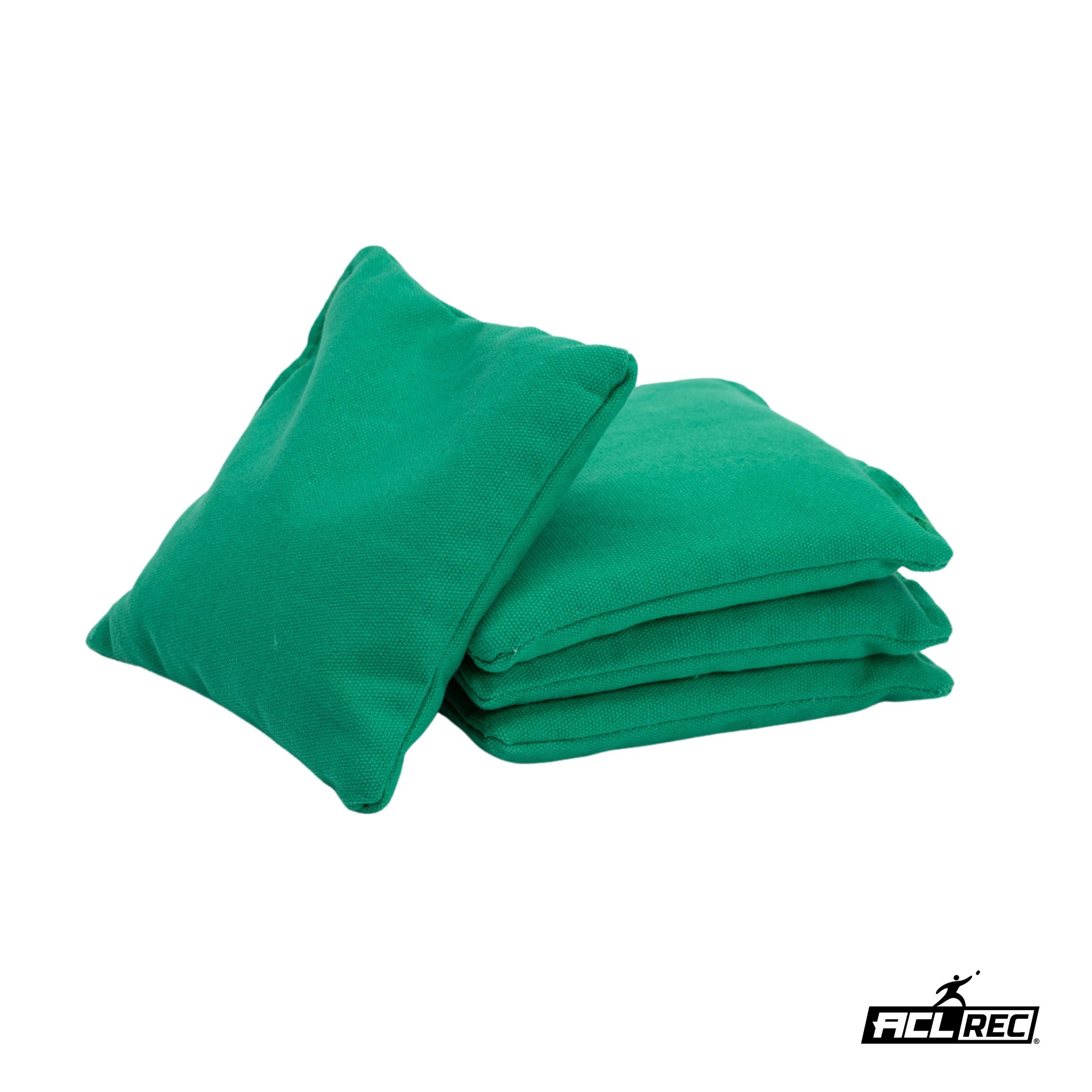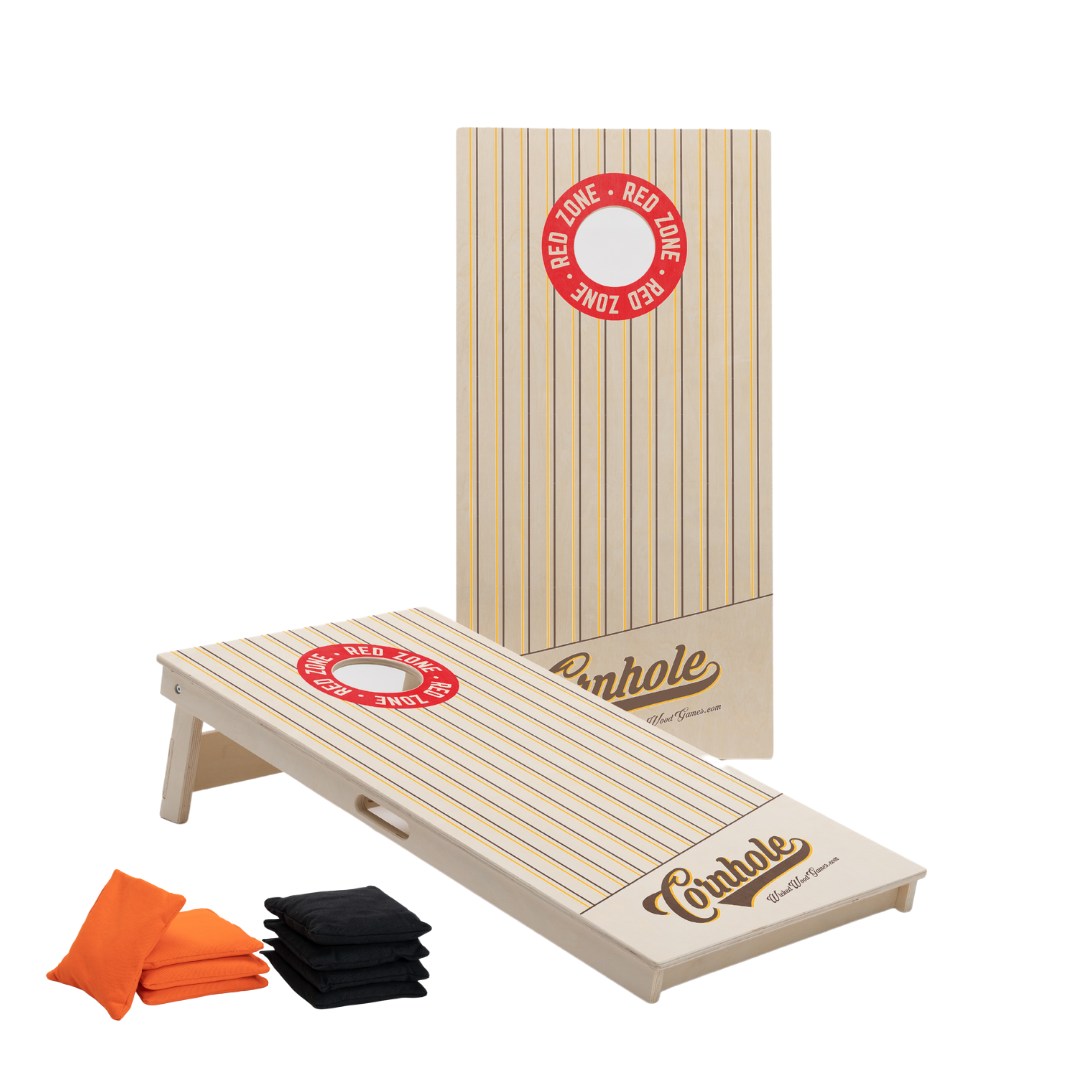Cornhole is a fun backyard game that's become really popular. It's easy to learn but can be challenging to master. Whether you play for fun or want to compete, knowing the rules is important. Cornhole has grown from a simple lawn game into a competitive sport with official tournaments. Let's look at the official cornhole rules and some fun variations to help you play like a pro!
Cornhole Rules and Gameplay
- Game objective: Be the first team to reach 21 points or more
- Equipment: Two boards with holes, placed 27 feet (8.23 meters) apart
- Scoring: 3 points for bags in the hole, 1 point for bags on the board
- Gameplay: Players take turns throwing 4 bags each per round
- Cancellation scoring: Only one team can score per round
- Backyard rules: Distance between boards can be shortened for casual play
- Foul line: Players must not step past the front edge of the board when throwing
- Underhand throws only: Overhand throws are not allowed

1. The Basics: Setting Up Your Cornhole Court
Before you start playing, you need to set up your cornhole court correctly. The right setup is important for fair play and can affect your game strategy. Here's what you need to know:
- Court dimensions: 8-10 feet wide and 40-45 feet long. This gives players enough room to move around comfortably.
- Board distance: 27 feet between the front edges of the boards. You can make this shorter for casual games or if you're just learning.
- Board size: 2 feet wide by 4 feet long. For beginner play you can play with 2 by 3 feet boards as well.
- Hole diameter: 6 inches, centered 9 inches from the top of the board. This is the standard size for all cornhole games.
- Playing surface: Try to play on a flat, level surface. Grass, concrete, or special mats all work well, but make sure both ends are the same.
For backyard games, you can change these measurements to fit your space. Just make sure both teams are playing on the same type of court! Being able to play cornhole in different places is one of the best things about the game. Learn more about setting up your cornhole game to have the most fun and try different court layouts to make your games more exciting.
2. Equipment: Bags and Boards
To play cornhole, you'll need:
- 2 cornhole boards: These should be smooth so the bags can slide. You can paint or stain them, but keep the surface smooth. You can start with 1 board if you want to play with only 2 players.
- 8 cornhole bags (4 of each color): Having different colors helps you keep track of scores and avoid mix-ups during the game.
Official cornhole bags are 6 inches square and weigh between 15.75 and 16.25 ounces. They're usually filled with corn kernels or plastic pellets. The weight and size are carefully set to make sure the game is fair in competitions. For fun games at home, you can use any bean bags that are easy to throw, but using bags close to the official size will help you get better at the game.
What the bags are made of can change how the game is played. Bags filled with corn feel and sound traditional, while plastic pellets last longer and don't get wet easily. Some players like to use a mix to get the throwing feel they want. Check out different types of cornhole bags to find the ones you like best for how you play.
3. Gameplay: How to Play Cornhole
Now that you're set up, here's how to play cornhole:
- Split into two teams (singles or doubles): In singles, each person plays alone. In doubles, teams of two take turns throwing.
- Choose which team goes first (use the bag for tossing who starts first): This can be important, so decide fairly.
- Players take turns throwing bags at the opposite board: This back-and-forth lets players adjust their strategy based on what their opponent does.
- Throw all bags, then add up scores: Each player throws four bags per round, which lets you try different ways of placing your bags.
- The team that scored in the last round throws first in the next round: This rule adds strategy, as the team in the lead can control the game's pace.
- Keep playing until a team reaches 21 points or more: The score can change quickly, so stay focused the whole game. For more backyard fun you can play backyard rules where you have to end up with EXATCLY 21 points.
Remember, all throws must be underhand, and players must stay behind the front of the board when throwing. This underhand rule makes sure everyone plays fairly. How you move your feet is also important; players often develop a rhythm for their throw, kind of like in bowling.
Some strategies to think about while playing:
- Blocking: Putting bags in front of the hole to make it harder for your opponents to score
- Pushing: Using your bags to move your own or your opponent's bags to better spots
- Sliding: Learning how to throw so your bag slides smoothly into the hole
Check out these detailed cornhole rules to learn more specific ways to play and understand the little things that can help you win.
4. Scoring: Counting Your Points
Scoring in cornhole is easy to understand, but it's important to know about the cancellation method, which adds strategy to the game:
- Bag in the hole: 3 points (Cornhole) - This is what you're aiming for and can quickly change who's winning.
- Bag on the board: 1 point (Woody)- Even if you miss the hole, keeping your bag on the board is still good.
- Bag touching the ground: 0 points (Foul Bags) - Any bag that touches the ground before getting to the board doesn't count.
-
The approved method of scoring for the sport of cornhole is “cancellation” scoring. In cancellation scoring, the points of one player cancel out the points of their opponent. Using this method, only one player/team can score in each frame.
After each round, subtract the losing team's points from the winning team's points. The difference is the score for that round. For example, if Team A scores 5 points and Team B scores 3 points, Team A gets 2 points for that round. That is the score that is added to the total to get to 21.
This way of scoring makes the game more strategic:
- It makes players think about defense, because knocking off an opponent's bag can be as good as scoring yourself.
- It lets teams catch up quickly, as a good round can close a big point gap.
- It makes players think about their own throws and what their opponents might score.
Some other things to remember about scoring:
- The score is taken at the end of the round, so other bags can influence the scoring.
- Bags that bounce off the ground onto the board don't count.
- A bag that is pushed through the hole by another bag will count as 3 points.
- A bag that is pushed off the board during play doesn't count at the end of the round.
5. Fouls and Violations: Playing Fair
To keep the game fair and fun, watch out for these common fouls:
- Stepping over the foul line (front edge of the board) when throwing: This is one of the most common mistakes and can give a player an unfair advantage.
- Throwing a bag from outside the pitcher's box: Players need to stay in the right area to make sure everyone throws from the same spot.
- Distracting an opponent during their throw: This includes making loud noises, sudden movements, or anything else to throw off the other player.
- Taking longer than 20 seconds to throw: This rule keeps the game moving and stops players from stalling.
If a player commits a foul, their throw doesn't count and the bag is taken off the board. In friendly games, you might be more relaxed about these rules, but in competitions, they're strictly followed. It's a good idea to talk about how strictly you'll follow these rules before you start playing.
Some other things to think about for fair play:
- Clean off the boards between games to make sure the surface is the same for everyone.
- If it's windy, all players should agree on what to do if the wind moves bags after they've been thrown.
- If a bag gets damaged during play, replace it right away to keep things fair.
6. Winning the Game: Race to 21
The first team to reach or go over 21 points wins the game. But there are a few important things to remember that can change how you play at the end of the game:
- Some players use a "skunk" rule, where the game ends if a team gets to 11 points while the other team has 0. This makes the game more exciting and can make players try harder at the beginning.
- In tournaments, games might be played to a different score or with a time limit. These changes can really affect how you play, especially in timed games.
Strategies to think about near the end of the game:
- When you're close to 21, you might want to play more defensively to stop your opponent from scoring while you try to win.
- Be aware of the "bust" rule in some games, where going over 21 resets your score to 13 or 15.
- In close games, focus on scoring consistently rather than trying risky throws that might backfire.
Learn more about official cornhole tournament rules if you're interested in playing in competitions. Knowing these details can really help you in organized tournaments.
7. Variations: Backyard Rules and Fun Twists
While the official rules are great for competitive play, many people like to change things up for casual games. These changes can make the game more exciting, fair for players of different skill levels, or just different:
- Shorter distances for kids or beginners (try 15-20 feet instead of 27): This makes the game easier and more fun for those who are still learning to throw.
- Playing to 11 or 15 points for quicker games: Great for when you want to play multiple games or don't have much time.
- Backyard "Bust" rule: You have to end up with exactly 21 points, if you go over your score will be reset to 13 or 15 points.
- Allowing bags to be thrown any way (not just underhand): This can lead to some fun and creative ways of throwing.
- Adding obstacles or targets on the board for extra points: Put smaller targets on the board or create zones for bonus points to make the game more complex.
- "Cornhole Golf" - create a course with multiple boards and keep score like golf: This turns your backyard into a cornhole course, adding variety and strategy.
More fun variations to try:
- "Around the World": Players have to hit specific spots on the board in a certain order.
- "Blind Toss": Players take turns throwing with their eyes closed, relying on muscle memory.
- "Partner Switch": In doubles, partners switch sides after each round, requiring adaptability.
- "Speed Cornhole": Set a timer and see how many points teams can score in a set time.
Remember, the most important rule is to have fun! These variations can keep the game fresh and exciting, especially if you play often. Explore more cornhole game variations to keep things interesting at your next backyard party or family gathering.
Backyard Rules:
8. Etiquette and Sportsmanship
Cornhole is a social game, so being a good sport is important to make sure everyone has a good time. Here are some tips to keep the game friendly and fun for all players:
- Wait for your turn and don't distract other players: Respect others when they're concentrating, and keep things quiet and calm during throws.
- Be honest about scoring and fouls: In friendly games, players often call their own fouls, so being honest is really important. If you're not sure about a call, offer to throw again or let your opponent decide.
- Encourage all players, no matter how good they are: Cornhole should be fun for everyone. Saying nice things can make the game more enjoyable and help new players feel welcome.
- Keep the trash talk light and fun: While some joking around can be fun, make sure it stays friendly and doesn't become mean.
- Thank your opponents for a good game, whether you win or lose: Showing appreciation for the game, no matter who wins, shows good character and sportsmanship.
More things to remember about being polite:
- Respect the equipment: Don't stand on the boards or mishandle the bags, especially if they don't belong to you.
- Be aware of what's around you: Make sure your throws and movements don't put spectators or nearby games at risk.
- Offer to help set up and clean up: This team spirit makes the social part of the game even better.
- Include everyone: If you're playing in a group, try to switch players or teams to give everyone a chance to play.
By following these guidelines, you'll make sure everyone has a great time playing cornhole and help create a positive, welcoming atmosphere that encourages people to keep playing and competing in a friendly way.
Conclusion: Toss, Score, and Enjoy!
Now that you know the cornhole rules, it's time to go play! Whether you follow the official rules or make up your own backyard versions, the most important thing is to have fun with friends and family. Cornhole is great because it's simple and everyone can play – people of all ages and skill levels can enjoy it.
As you play more, you'll develop your own throwing techniques, strategies, and maybe even some special rules that make the game extra fun for your group. Remember, practice makes perfect, so keep throwing those bags and you'll get better in no time!
Cornhole is more than just a game; it's a way to bring people together. It's perfect for backyard barbecues, tailgating at sports events, or even as a fun activity at work gatherings. You can play cornhole almost anywhere, which makes it a great choice for outdoor fun.
Ready to start playing cornhole? Check out our selection of high-quality cornhole sets and get ready for hours of fun. We have basic sets for beginners and professional-grade equipment for serious players. Happy tossing, and may your bags always find the hole!
Board Setup
27 feet (8.23 m) apart
Bag Specs
6 in (15 cm) square, 16 oz (450 g)
Scoring
3 in hole, 1 on board
Winning
First to 21 points or more
Questions? We'll help you right away!
We are always available at support@wickedwoodgames.com .
Or fill in the form below and we will contact you as soon as possible.




